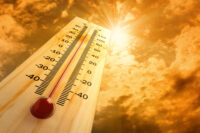
Record temperatures across the United States are causing dangerous heat waves. Heat index values ranging from 105-115 degrees or higher are affecting millions, according to the EPA. This can help to create what is known as the “urban heat island”. Luke Howard first investigated this phenomenon in the early 1800’s, but he wasn’t the one to name it. Satellite readings from NASA show where the heat islands are located.
Heat islands
As cities build up and infrastructure replaces land and vegetation, surfaces that were once moist become dry. This can spell trouble for dense, downtown areas where the heat becomes trapped in materials like concrete, bricks, and asphalt that retain heat. Since those types of materials are usually non-porous, there is less evaporative cooling. The heat that has accumulated during the day is released at night and is compounded by air pollution and low humidity, which occurs because of the lack of vegetation. The heat island develops during periods of calm conditions when there is no wind to disperse the heat. This affects a city’s quality of life and puts a strain on air conditioning.
The air temperature in an urban area of more than a million people can be 1.8-5.4 degrees warmer than the surrounding rural areas. The heat island affects air conditioning costs, pollution, heat-related illness and peak energy demand during a heat wave.
Extreme heat
Each year in the Unites States about a thousand people die from extreme heat. The increased heat and smog formed from a heat island harms human health and contributes to the deaths from heat-related problems.
Some ways to offset the heat islands would be to have more trees, plants and bushes. Also, having a rooftop garden is a way of offsetting it. This helps lower the cost of electric bills as it transfers the heat in lower rooms. Using lighter colored asphalt and shingles that reflect light can help. Cities can introduce more green spaces and parks, along with choosing proper building materials.
The elderly and young children are more susceptible to the heat and should use caution when the temperatures rise. This becomes even more dangerous when the temperatures are high for more than two days at a time. People who live in urban areas face a much greater risk of being in an extreme heat wave than their rural counterparts. You can learn more about the risk in your area and how to beat the heat by staying in touch with the National Weather Service or updates from your local station.

Connect with Me